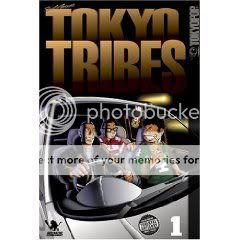Tokyo Tribes Vols. 1 & 2
Santa Inoue, writer/artist
Tokyopop, 2005
200 pages or so each
$9.99 each
Originally written on May 8, 2005 for publication in The Comics Journal
You don’t need to know which of New York City’s five boroughs is also known as “Shaolin” to grok that the pop cultures of the Far East and the inner-city West have been happily cross-pollinating at least since Jim Kelly’s afro entered the dragon. From the RZA’s obsessive referencing of films like Five Deadly Venoms and Shogun Assassin to Jay-Z’s name-checking of Tokyo’s Bathing Ape clothing label to the almost neurotic Japanophilia of Gwen Stefani’s legion of big-name hip-pop producers, urban American tastemakers have happily pillaged Asian culture. Tokyo Tribes attempts to flip the script by grafting hip-hop fashion, patois, and pseudo-Shakespearean self-aggrandizement onto the visual language of manga. And woof, what a mess it makes.
Tokyo Tribes follows a pair of estranged friends, Kai and Mera, who have come to be leaders of rival Tokyo street gangs. While Kai’s “tribe” is a relatively peaceful one, Mera’s is puppet-mastered by Bubba, a genuine crimelord with the girth and coif of the Kingpin and the appetites of Caligula. Various shady enterprises and deceitful underlings cause the two to come into conflict, but the plot mechanics are practically an afterthought; the real focus is on the moments of excess–hip hop’s true stock in trade, after all.
In this regard writer/artist Inoue is probably a student of Brian DePalma’s Scarface, the Oliver Stone–penned epic of bad taste that has become hip-hop’s over-the-top stylized-crime Talmud. That film’s moments of outrageous violence–the chainsaw scene, “Say hello to my little friend!”–work with a breezily cheesy and offensive gusto, modeled as they are after similarly larger-than-life moments in the gangster films of the ’30s and embedded within one of the greatest displays of sceneryphagy in cinematic history. Inoue has simply detached them from context, played up their most lurid aspects, and expected his audience’s affinity for the cultural touchstone’s he’s hitting upon to help him pull it off.
It doesn’t work. We are hardly a handful of pages into the book before an overzealous rookie cop has an eye gouged out by a member of one of the tribes, in full view of not only a street full of passerby but of his own partner. I understand that we’re to see the tribes as the power in the city, but even The Godfather acknowledged that in attacking policemen is taboo for even the most powerful of criminal organizations. Bubba, meanwhile, is quite explicitly modeled after Scarface‘s Tony Montana, perhaps after 30 years and 300 pounds were added on; a globe in Bubba’s opulent foyer affixed with the legend “Fuck the World” invites direct comparisons to Montana’s similar “The World Is Yours” motto, and those comparisons are not favorable. (Whoever thought we’d yearn for the subtle nuances of the script that gave us the phrase “This town’s like a giant pussy just waiting to get fucked?”) His incredibly, and I mean that in every sense of the word, graphic and sexualized outbursts of violence are so out of left field and so far removed from the strictly-business ethos of hip-hop crime that they deal the book a blow it’s unlikely to recover from. This suspension-of-disbelief-shattering aspect of the story is only heightened by the “censored” bars superimposed, with Inoue’s approval, on nude body parts throughout the series: We’ve just seen a fat old man anally rape a young boy until the victim’s body literally bifurcates, and now all of a sudden we’ve got to hide nipples behind black bars? (On the other hand, the censored bars do mitigate against Inoue’s tendency toward making all his woman characters either ethereal damsels in distress or straight-out sex objects, all too often literally so.)
Inoue’s line is loose and idiosyncratic, different than either the slickness of typical male-oriented manga or the bubbly design of the graffiti aspect of hip-hop culture. Since it belongs fully to neither world, it can occasionally bridge them rather effectively. Perhaps its strongest moment is in the rooftop-to-rooftop chase and swordfight that kicks off Volume 2, a truly thrilling sequence that takes advantage of comics’ ability to expand and juggle time and space in the context of action. (In its way, it’s reminiscent of some sequences from another East-West fusion, Quentin Tarantino’s Kill Bill films, which of course bore a comics influence far more formal, and more profound, than David Carradine’s Jules Feiffer-cribbed Superman speech.) But Inoue immediately cuts the strength of the scene off at the knees by revealing that the dizzying heights our characters have been battling in are actually close enough to the street that one of them can drop down to the ground and incur barely a scratch. And then a rival gangster drives up wearing a samurai helmet and driving a tank. Sigh. Inoue forgets that for all its braggadocio, hip hop’s roots are as “the black CNN,” a mirror–a funhouse mirror, perhaps, but a mirror nonetheless–on the reality of life in the big city. I don’t care if the city in question is Tokyo rather than the South Bronx or South Central–it’s still got to be real.
Tags: comics, comics reviews, Comics Time, reviews

